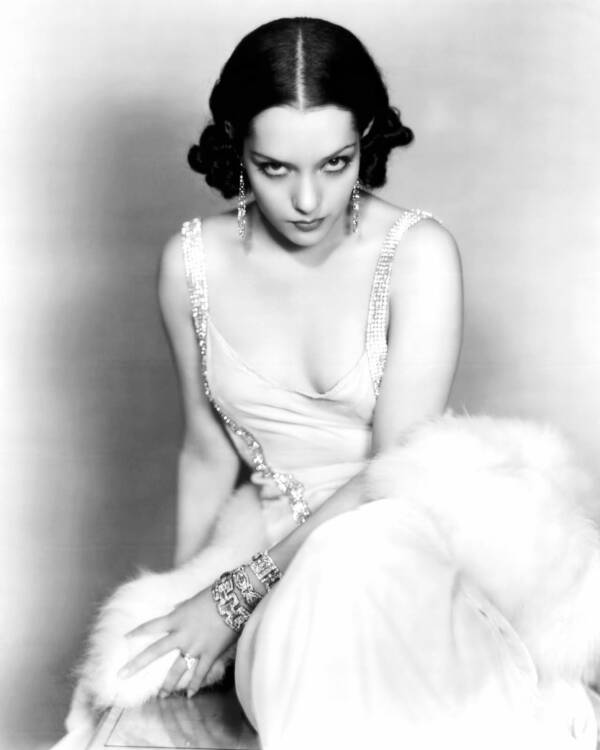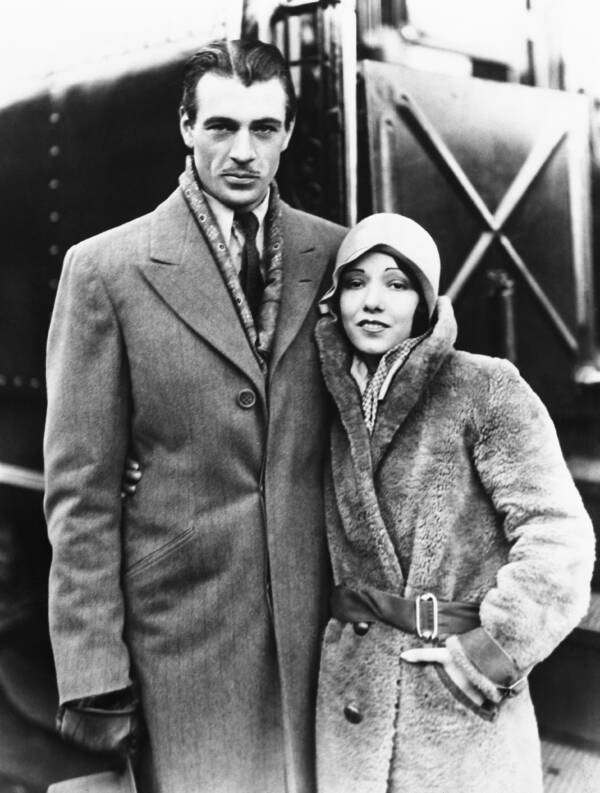Lupe Vélez blazed new trails for Latinas in Hollywood before her shocking and controversial suicide in 1944.

Hulton-Deutsch Collection/CORBIS/Corbis via Getty ImagesMexican film actress Lupe Vélez took Hollywood by storm in the 1930s.
Drama followed Lupe Vélez wherever she went. It dogged her in her hometown of San Luis Potosí, Mexico, trailed her to Hollywood, haunted her into taking her own life, and echoed on after her death. Even Vélez referred to herself as a “devil.”
After coming of age during the Mexican Revolution, Vélez propelled herself from her childhood home and into stardom. The dark-haired, five-foot-tall actress commanded attention in Hollywood and went on to star alongside the likes of Douglas Fairbanks and Laurel and Hardy.
But though Vélez’s extreme emotions made her famous and drew in lovers like Gary Cooper, they also proved to be her undoing. Pregnant and distraught that the baby’s father would not marry her, Vélez resolved to take her own life with sleeping pills in 1944.
Since then, Lupe Vélez’s death has taken on a life of its own. Some claimed that she’d actually gotten pregnant by Cooper. Others insisted that she had not died of a drug overdose at all, but had drowned with her head in the toilet.
This is the fact and fiction of Mexican actress Lupe Vélez’s life, from her astonishing rise to fame to her tragic demise.
From A Simple Life In San Luis Potosí To Star-Studded Hollywood
Lupe Vélez, born María Guadalupe Villalobos Vélez, had a dramatic life from the beginning. She came into the world on July 18, 1908 — allegedly during a violent storm — in the Mexican town of San Luis Potosí.
She spent her early years accompanying her father, Jacobo Villalobos Reyes, to various battles of the budding Mexican Revolution. As Vélez later said, this violent but formative experience made her fearless.
“When your American kids go to kindergarten, I am riding with my father in the Mexican Army. I see the horse of my brother shot beneath him. I see many mens try to kill my father. I see my father kill other peoples,” Vélez explained in the March 1929 edition of Screen Secrets.
“It is my first school, thees revolution. I do not cry. I do not have goose pimples on my flesh. I do not have fears of the bullets.”
Vélez also developed a love for acting at a young age. “From the time I see my first movie, I am an actress,” she told Screen Secrets.
According to the book Lupe Vélez: The Life and Career of Hollywood’s “Mexican Spitfire,” at around the age of 10 she started putting on shows for her family’s servants. By 12, she’d begun sneaking into local theaters to study how the actresses dressed, did their make-up, and performed.
The aspiring actress also imbued her home life with plenty of drama. “My poor family,” she told Screen Secrets. “They never know what to do with me… My three sisters… like to be ladies. They make me nervous, being always so good like a lady. They have no fun.”
But Vélez, her parents decided, was having too much fun. Concerned about their 13-year-old’s flirtatious behavior and her 21-year-old boyfriend, they decided to ship her off to a San Antonio, Texas convent, as reported by Los Angeles Magazine. There, Vélez continued to make mischief, and her punishment — writing “I must be good” — didn’t seem to dampen her spirits.
She returned home after her father went missing in action during the war, and she worked for a while to support her family. Still drawn to the screen, Lupe Vélez also began to perform at local theaters.
Her physicality, charisma, and ability to improvise — Vélez wasn’t fazed when her ukulele strings broke during one performance — set her on the path to stardom. Before long, an American actor named Richard Bennett invited Lupe Vélez to try her hand in Hollywood.
How Lupe Vélez Became The ‘Mexican Spitfire’

Silver Screen Collection/Getty ImagesLupe Vélez circa 1930.
At first, life in Hollywood was heartbreaking for Lupe Vélez. Bennett had invited her to perform in his play The Dove but decided to go with another actress. Nevertheless, he introduced her to his Hollywood associates, which led to Vélez’s casting in The Gaucho (1927) opposite Douglas Fairbanks.
“Lupe Vélez acts the part of the Mountain Girl, a termagant, quickly fired to anger,” the New York Times wrote of her performance. “Whether she is in rags or laces she gives blow for blow to the men who get in her way or incur her anger. She, too, springs on horseback, never heeding for an instant that she is arrayed in silks and laces.”
From there, Vélez began her ascent to fame. She starred in Hollywood films, acted on Broadway, and demonstrated her comedic chops alongside comedy duo Laurel and Hardy in 1934’s Hollywood Party.
Vélez also became known for her wild temper. She threatened to cut a fellow actress’ throat because she’d dared to wear red to a party with an all-white dress code, came to blows with her female co-star in the musical You Never Know, and attacked a referee with an umbrella at a boxing match.
Vélez also racked up a number of Hollywood love interests, including Gary Cooper, whom she acted alongside in Wolf Song (1929), and Tarzan actor Johnny Weissmuller.

Bettmann/Getty ImagesLupe Vélez and Gary Cooper in 1929.
Both were tumultuous relationships. Before Vélez and Cooper parted ways in 1931, Vélez had stabbed him, shot at him, and butted heads with his mother. Weissmuller, whom she married in 1933, often showed up to set covered with bites and scratch marks before their divorce in 1939.
But despite Lupe Vélez’s success — and her high profile romances — she often found herself relegated to playing “ethnic” characters.
Between 1939 and 1943, she acted in the Mexican Spitfire series as a stereotypical Latina woman who spoke “Spanglish.” And throughout her career, gossip columnists maligned her with names like “Mexican Hurricane,” “Whoopee Lupe,” and “The Hot Tamale.”
What’s more, Hollywood was changing. While Vélez had thrived in the sexually-charged films of the 1930s, new censorship laws made it harder for her to find parts in the more morally upright 1940s, according to the Los Angeles Times.
Then, in 1944, Lupe Vélez found out that she was pregnant.
The Strange And Tragic Death Of Lupe Vélez

Archive Photos/Getty ImagesLupe Vélez in the early 1940s, shortly before her tragic suicide.
As the official story goes, Lupe Vélez discovered she was pregnant while seeing the Austrian actor Harald Ramond. But their relationship went sour in early December 1944, with the Los Angeles Times reporting on Dec. 10 that they’d broken up.
On Dec. 13, Vélez dined with two of her friends, Estelle Taylor and Venita Oakie. Taylor, who was with Vèlez from around 9:30 p.m. to 3:30 a.m., remembered that Vélez seemed depressed. At one point, according to the New York Times, the actress had said, “I am getting to the place where the only thing I am afraid of is life itself.”
But Lupe Vélez was more depressed than Taylor realized. In the early morning hours of Dec. 14, 1944, she wrapped herself in a dressing gown, took 75 sleeping pills, drank a glass of brandy, and lay down upon her silk sheets. She was found dead later that morning by her secretary, Beulah Kinder.
Vélez had left two suicide notes. The first, addressed to Harald, read:
“May God forgive you, and forgive me too but I prefer to take my life away and our baby’s, before I bring him with shame or killing him.”
“How could you Harald, fake such great love for me and our baby when all the time you didn’t want us. I see no other way out for me, so goodbye and good luck to you.”
The other note was for Kinder, with instructions for her to take care of Vélez’s dogs, Chips and Chops.
In the aftermath, Ramond professed his innocence in the whole affair. “I am so confused,” he said. “I never expected this to happen. The last time I talked to Lupe I told her I was going to marry her any way she wanted. She said then she wasn’t going to have a baby. So we parted.”
Though Ramond admitted that he’d once asked Vélez to sign a document saying that they were only marrying to “give the baby a name,” he said that he’d said that in a “terrible temper.”
But that wasn’t the only odd thing about Lupe Vélez’s death. In the decades afterward, her suicide took on the specter of legend — thanks to Kenneth Anger, who offered a different interpretation in his book Hollywood Babylon.
Anger claimed that Vélez had taken the sleeping pills, then become violently ill and drowned in her own toilet. This interpretation has been oft-repeated, including on Frasier and The Simpsons. But it doesn’t seem to stand up to scrutiny.
Clinton H. Anderson, the Beverly Hills Chief of Police in 1944, was one of the first on the scene. “We found her dead in bed in her home,” he wrote in his memoir Beverly Hills Is My Beat, a claim backed up by recently rediscovered photos of her body published by HuffPost.
Anderson also suspected that Vélez had meant to merely stage an attempted suicide but had miscalculated the number of pills. “I believe Lupe thought her act would bring her faithless lover back,” he wrote.
As for the paternity of Lupe Vélez’s baby? Her suicide note and relationship with Ramond suggest that he was the father. But according to the New Yorker, some have speculated that Vélez was actually pregnant with Gary Cooper’s child.
In the end, Lupe Vélez’s extreme emotions — her soaring highs and devastating lows — brought about her untimely death. But it also brought her from Mexico to Hollywood, and from acting in local theaters to sharing a screen with some of the best actors of the generation.
“My life story?” she once said. “It is the story of a devil. And who wants to print the story of a devil? I am wild, I cannot help it.”
After reading about the life and death of Mexican actress Lupe Vélez, look through these photos of vintage Hollywood. Or, discover the stories behind vintage Hollywood’s biggest scandals.





